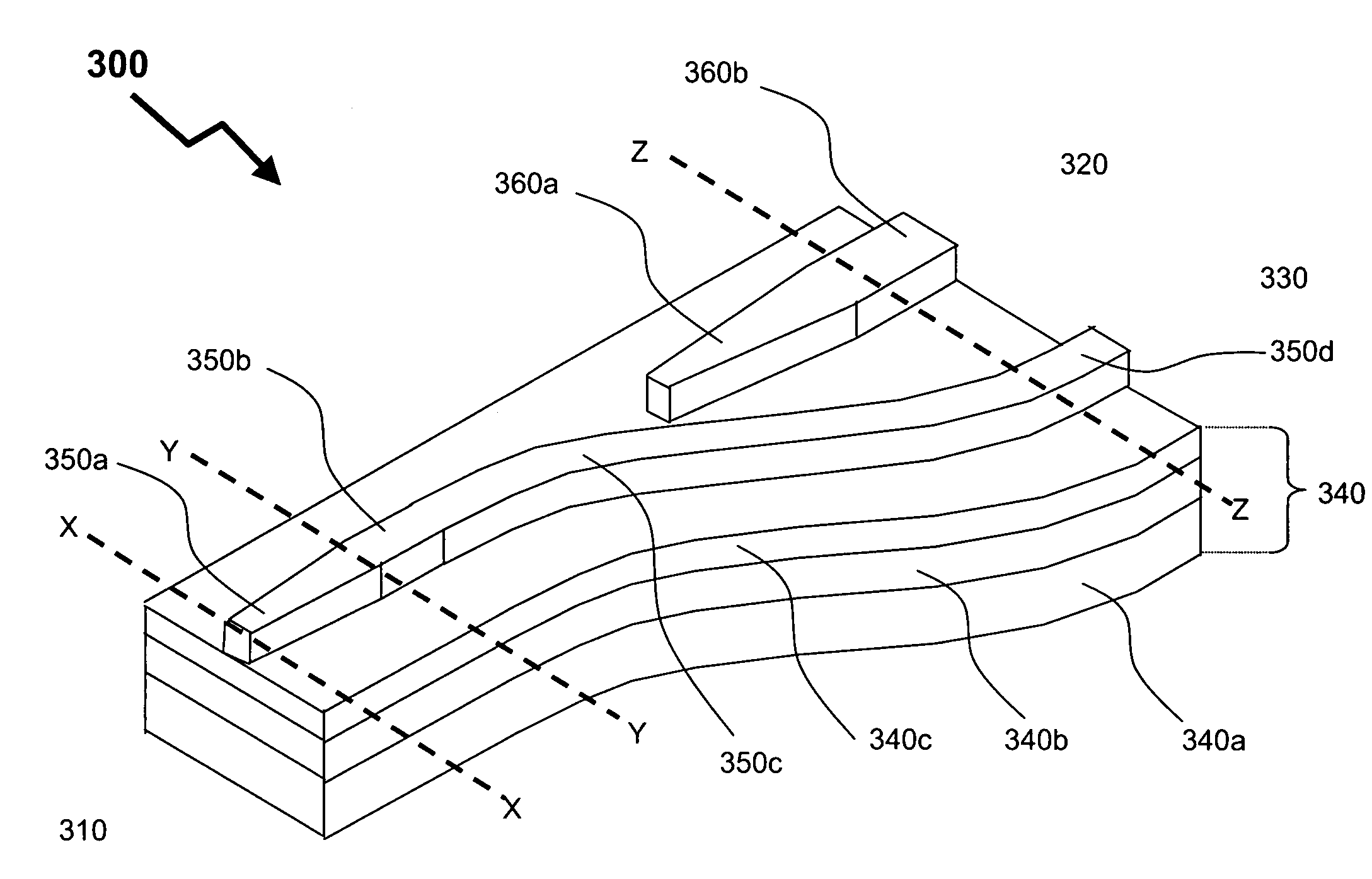Integrated optics arrangement for wavelength (De)multiplexing in a multi-grade vertical stack
a vertical stack and integrated optics technology, applied in the field of integrated photonics, can solve the problems of inability to deliver competing technologies, e.g. those based on twisted copper, coaxial cable or wireless transmission, and deep penetration of optical fiber into access networks that require an unprecedented massive deployment of optical gear, and the cost efficiency and volume scalability of such components are increasingly becoming the major issues
- Summary
- Abstract
- Description
- Claims
- Application Information
AI Technical Summary
Benefits of technology
Problems solved by technology
Method used
Image
Examples
first embodiment
[0043]The solution to this problem is illustrated by FIG. 2, which gives a schematic three-dimensional view of the present invention in the form of two-wavelength VWM 200 having one common waveguide and two wavelength-designated waveguides. Whereas the bottom part of this waveguide arrangement is similar to that of the previous art, shown in FIG. 1, there is a fundamental difference in design and operating principle between the two.
[0044]Design-wise, the MGVI structure is different in that the guiding layer of the first designated waveguide is now composed of two layers, each capable of supporting the guided mode in the first operating wavelength, of which the lower core layer is transparent for this wavelength (i.e. made up from the semiconductor material having the bandgap wavelength well above the first operating wavelength). Another design difference is in that the waveguide router is formed in the lower core of the guiding layer of the first designated waveguide is lateral, suc...
second embodiment
[0064]FIG. 5 illustrates the second embodiment related to the lateral router aspect of the invention, in which the waveguide bend section of the transition waveguide 510c of a two-wavelength VWM 500 is complemented with a curved deep trench 510d, etched in the proximity of the waveguide bending, such that, in use, it provides an additional lateral confinement to the waveguide mode propagating therein and, therefore, reduces its leakage from the bended section of the transition waveguide, therefore, improving the insertion loss for the first wavelength. A combination of the sharp waveguide bending and curved trench, similar to that shown in FIG. 5, has been proven in the previous art to be an efficient solution to a leakage problem occurring at the waveguide bend, see for example Seo et al. (“Low Transition Losses in Bent Rib Waveguides”, J. Lightwave Technology, Vol. 14, No. 10, PP. 2255-2259, 1996). Further improvements of the same nature can be achieved by adding continues / segment...
third embodiment
[0065]Now referring to FIG. 6, illustrated is the lateral router aspect of the invention, in which the lateral re-direction of the first wavelength still is achieved by bending the transition waveguide 610c, but a lateral ARROW structure 610e through 610g defined by semiconductor etching process next to the waveguide bend is employed as an additional feature serving to reduce the leakage of the optical mode from the bended section of the transition waveguide. The design and operating principles of the ARROW structures 610e through 610g are well described in the previous art, see for example Galarza, et al (“Simple low-loss waveguide bends using ARROW effect”, Appl. Physics B, Vol. 80, PP. 745-748, 2005). Bended lateral ARROW structure added on the outer side of the waveguide bend allows for higher bending curvature without extra loss, therefore, enabling for smaller footprint designs.
PUM
 Login to View More
Login to View More Abstract
Description
Claims
Application Information
 Login to View More
Login to View More - R&D
- Intellectual Property
- Life Sciences
- Materials
- Tech Scout
- Unparalleled Data Quality
- Higher Quality Content
- 60% Fewer Hallucinations
Browse by: Latest US Patents, China's latest patents, Technical Efficacy Thesaurus, Application Domain, Technology Topic, Popular Technical Reports.
© 2025 PatSnap. All rights reserved.Legal|Privacy policy|Modern Slavery Act Transparency Statement|Sitemap|About US| Contact US: help@patsnap.com



